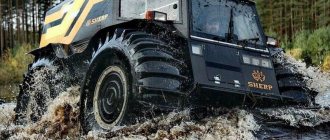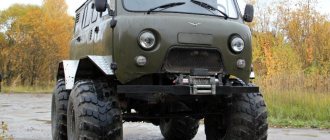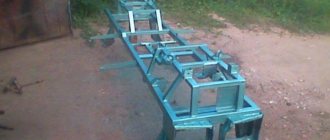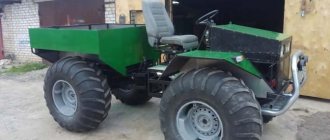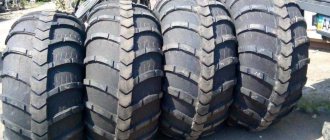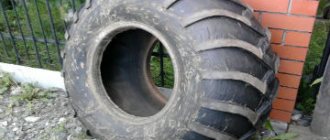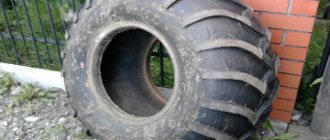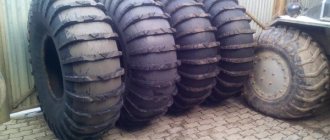An all-terrain vehicle is a type of ground vehicle used for movement in rough terrain. Such vehicles are used to transport people and goods and are popular among outdoor enthusiasts. All-terrain vehicles on low-pressure tires easily overcome difficult roads and off-road terrain.
Design features
The machine overcomes obstacles of varying complexity thanks to large-diameter wheels, which reduce pressure on the soil and increase ground clearance.
Other design features:
- The special tread pattern provides strong grip on the ground.
- The basis of the design is an articulated frame, thanks to which the wheels are placed at the desired angle. This ensures the stability of the vehicle and prevents the all-terrain vehicle from overturning on a large slope.
Low pressure chambers have an increased internal volume (pressure - from 0.1 to 0.4 MPa). The tire has fewer cord layers and less voluminous side surfaces compared to classic products. Wheel components:
- tread;
- frame (consists of metal or synthetic threads);
- side strips (made of natural rubber);
- breaker (belt made of steel cord);
- fender tape (synthetic elastomer);
- steel ring rod.
Low pressure wheels have a collapsible disc. It is equipped with a device that prevents the tire from slipping off the rim. Tires are soft, elastic and shock-absorbing. Thanks to such wheels, the car moves smoothly on a relief surface.
The best car models for fishing and hunting: features and advantages
The legendary UAZ Patriot SUV is an ideal vehicle for fishermen and hunters: roomy, with good cross-country ability - it can easily drive through mud, swamps, and also allows you to cross fords. The power of the UAZ Patriot is 135–150 hp. With. The engine runs on gasoline, so fuel consumption in the combined cycle ranges from 9.5 to 14 liters per 100 km, depending on the configuration. The ground clearance is 210 mm. The trunk with a volume of 1130 to 1200 liters can accommodate even large cargo.
UAZ Hunter is a car with high ground clearance (from 210 to 241 mm). The 470-liter trunk will fit everything a hunter or fisherman needs: from a tent to a week's worth of food. Increased load capacity up to 750 kg makes it possible to transport large and heavy loads. The UAZ Hunter is available with a 2.7 liter gasoline engine with a power of 128 hp. With. and is equipped with a five-speed manual transmission.
The Chevrolet Niva with all-wheel drive is equipped with a 1.7-liter gasoline engine whose power reaches 80 hp. With. and a five-speed manual transmission. The suspension is so energy-intensive that it allows you to drive quickly on country roads and broken roads. At the same time, the chassis of the Chevrolet Niva is durable and quite reliable.
Land Rover Defender 110 has an impressive ground clearance of 250 mm. The 400-liter trunk, if you fold the second row of seats, increases to 1400 liters. The Land Rover Defender's 90-liter fuel tank allows you to travel a long distance without refueling.
Varieties
There are not only wheeled all-terrain vehicles, but also tracked ones. The latter option is used when completely off-road, when moving through washed-out clay soil. A separate group includes sealed snow and swamp-going vehicles that can overcome any water obstacles.
According to the type of control, all-terrain vehicles can be:
- with automatic transmission;
- with manual control.
There are also types of machines based on their area of application. There are 4 classes of all-terrain vehicles:
- passenger (for tourists, hunters and fishermen);
- cargo (transportation of equipment and materials);
- cargo and passenger (used by forwarding and geological teams);
- industrial purposes (special equipment equipped with additional equipment).
There is also a classification for low pressure tires. There are 4 types:
- Toroidal. Versatile and durable, the profile is close to the diameter of the wheel.
- Arched. The tire pressure level does not exceed 0.05 MPa. The width can be 5 times greater than a standard tire. Installed on the drive axle, they overcome any off-road conditions.
- Pneumatic rollers. They are large in size, the surface is equipped with load hooks. They have a strong cord and are superior in elasticity to arched models. Not used for heavy loads.
- Wide-profile. Designed for special equipment and heavy loads.
There are also tubed and tubeless tires. The second type does not deform under load. The end sides of the wheels have additional sealing; the inner layer is 2 mm thick, which ensures high sealing. These tires have a low degree of comfort.
Chamber versions have less weight, but are subject to mechanical damage and can deform under load.
In addition to factory models of vehicles, there are homemade all-terrain vehicles, which are often not inferior in their technical characteristics.
Cabin features and capacity
The weight of the equipment and its maneuverability depend on the number of passengers. The most nimble are two-seater all-terrain vehicles. Most of them don't even have a cabin - they look like motorcycles. Another advantage is their low fuel consumption. They are chosen by rangers and rescuers for fast movement over long distances.
To go outdoors with a large group, you need all-terrain vehicles with a cabin that can accommodate 4–6 people. Models with a heated cabin and a closed body are good for long trips in cold climates.
Advantages and disadvantages
Wheeled all-terrain vehicles are distinguished by high maneuverability, reliability and endurance; most models are equipped with a powerful generator. Brake pads located on the rear shaft ensure climbing on steep slopes.
Advantages of all-terrain vehicles:
- Modern car models include an air conditioning system, a power steering option, sound insulation, and comfortable seats. All this makes being in the cabin comfortable.
- An autonomous generator and an increased fuel tank volume allow the vehicle to be operated for a long time in extreme conditions and remote areas.
- All-terrain vehicles are suitable for moving on any type of soil. It is necessary to choose the right tread pattern (for example, a shallow pattern is suitable for peat bogs, a shallow narrow pattern makes it easier to move on snow and sand).
- Due to the slight pressure on the soil, deep pushing of the surface is eliminated, due to this the machine is able to reach high speeds.
- The increased contact patch with the ground not only increases cross-country ability, but also reduces soil damage when located in environmental areas.
The disadvantages of wheeled all-terrain vehicles include rapid tire wear when regularly moving on concrete and asphalt. Other cons:
- Due to their weak profile, all-terrain vehicles react sensitively to aggressive driving style.
- At high speeds on sharp turns, the machine may overturn, because the center of gravity shifts. Maneuvers should be performed smoothly.
- Movement on public roads is limited due to non-compliance with traffic police requirements.
The maximum tire load limits the design of the all-terrain vehicle. Homemade builders often prefer 6-wheeled options, and they also make 8-wheeled vehicles. With a lightweight body of its own design, the load-bearing capacity of the vehicle increases.
Top economy SUVs
Russia is famous for its off-road conditions. Therefore, it is not surprising that the majority of all-wheel drive all-terrain vehicles in the price segment up to $10,000 are made in Russia. Many car enthusiasts, of course, do not trust the domestic auto industry. However, the list above contains the most reliable economy class SUVs.
UAZ Patriot
The advantages of the rating leader are quite clear. The car is perfect for use within the city and beyond, is easy to repair, and consumes about 10 liters of gasoline per 100 km. The dimensions also meet the requirements of travel enthusiasts. The seats in the cabin can be conveniently reclined, allowing you to accommodate up to 4 people while sleeping. The cost of a new Patriot is 12,000 dollars, a used one – from 6,000.
Now as for the shortcomings. The front-wheel drive is activated separately, the gearbox is only mechanical. When choosing a car, it is important to pay attention to the assembly. The owners of this model note that assembly by the Ministry of Defense and the Ministry of Emergency Situations is of the best quality.
UAZ Hunter
From the name of the model it is clear that the car was developed specifically for use in rough terrain. Separately, it is worth noting that this is a modification of a military vehicle. The car is spacious, has high ground clearance, and is extremely reliable. Engine volume depends on the type of fuel: for gasoline - 2.7 liters, for diesel - 2.2 liters.
Hunter has two significant drawbacks. Firstly, it is difficult to use as a station wagon, since it handles unsteadily on city roads. Secondly, the cost of a new car in the basic configuration is as much as $12,000. For this amount you can buy a used Japanese or German-made jeep.
Niva 4×4
Many car enthusiasts compare this Niva model to a tractor. Well, it cannot be said that they are completely wrong. Low noise insulation, stiff suspension, three-door body - this car can hardly be called comfortable. But it has a lot of advantages that make the car popular. The advantages of this vehicle include reliability, maximum off-road capability, low fuel consumption, and spacious luggage compartment.
Niva Chevrolet
It’s worth noting right away that this car can be successfully used for hunting and fishing only after tuning. This modification of the classic Niva is a budget version of a modern jeep. It differs from the previous model in increased comfort, however, due to decreased cross-country ability and reliability, the Chevrolet Niva occupies only 4th place in the rating. The cost of the car depends on the modification. A good option can be found within $10,000 for a new car, and 6,000 for a used one.
Suzuki Jimny
Many hunters and fishermen prefer the old but reliable Suzuki Jimny. This Japanese SUV with 4x4 torque transmission and high ground clearance is easy to use in all conditions. The advantages of this model are spaciousness, high maneuverability, low fuel consumption.
The disadvantages of the car include the cost of repairs, the difficulty of finding parts, and the high cost of a new car. A used car in good condition can be purchased for $6,000.
Review of popular models
There are several models of all-terrain vehicles that are in demand among outdoor enthusiasts, as well as used in various fields of agriculture. Each option is distinguished by high-quality assembly.
All-terrain vehicles Max
These machines are characterized by versatility. The two-seater, maneuverable Max 2 models and the six-wheeled Max 4 vehicles are popular. The latter option can accommodate 6 people and has good speed characteristics. On water it reaches speeds of up to 12 km/h, on ground – up to 75 km/h. The weight of the machine is 900 kg, the wheels are controlled independently. In the absence of refueling, it travels up to 200 km.
Argo all-terrain vehicles
The most common model is 8x8. The eight-wheeled amphibious all-terrain vehicle is capable of moving through water, snow, rocky and swampy areas.
The car is equipped with a 30 hp engine and a spacious luggage compartment.
Crawler Tinger
This all-terrain vehicle model seats 4 people, not counting the driver. On water bodies it reaches speeds of up to 4 km/h, on hard surfaces - up to 45 km/h.
The brake system is based on hydraulics; there are no chains in the drive (the axles are unloaded). The amphibious all-terrain vehicle has a closed design that allows you to move comfortably in any weather conditions.
Domestic Transmash models
The Russian manufacturer specializes in mass production of wheeled and tracked all-terrain vehicles. From the wide range of models, the following models can be distinguished:
- "Vetluga-Arctic". The all-metal body of tracked all-terrain vehicles has a high level of noise and vibration insulation. High-quality sealing ensures comfortable use of the machine at low temperatures. All-terrain vehicles are designed for 14 people (including the driver). The TTS 34017 model has 5 sleeping places.
- "Aldan." All-terrain vehicles of this model range are designed for transporting passengers and cargo. The snow and swamp-going vehicle is equipped with a cargo platform for placing equipment. Options for 16 and 6 seats are available.
The Kerzhak model range includes snow and swamp-going vehicles for 3, 6 and 13 people. The loading platform allows you to place technological equipment. The vehicle overcomes minor water obstacles and is operated in partial off-road conditions.
All-terrain vehicle Tarus 2×2
The two-wheeled all-terrain vehicle is lightweight and has good cross-country ability; it is equipped with a 7 hp Honda engine. The vehicle reaches speeds of up to 35 km/h. The collapsible design allows you to transport it to the desired point in the trunk of an SUV.
Caracata 4x4 all-terrain vehicles from 130 thousand rubles in stock. Fracture swamp vehicles are available and can be ordered at manufacturer prices in the Master Techno catalog.
The Master Techno company has been selling and testing caracats from a variety of manufacturers for a long time. We will always tell you about all the advantages and disadvantages of the design of different models and help you make the right choice of caracat or select a KIT kit for assembly.
History of the creation of caracats:
The very first caracats appeared in the late 80s in the Vologda region and were initially three-wheeled and built on the basis of Voskhod and IZH Planet motorcycles. Craftsmen modified the motorcycle frame to accommodate the installation of cameras from trucks or lightweight wheels from agricultural machinery (ROU-6 - organic fertilizer spreader).
Thanks to large wheels and low specific pressure, the vehicle performed well in swampy areas, but at the same time it was inferior in cross-country ability in snow, due to the lack of all-wheel drive and aggressive wheel tread. The front wheel rested on the snow, and the all-terrain vehicle was helplessly grinding with its rear wheels. The problem was solved by installing a ski instead of the front wheel, but still full-fledged driving on snow was not possible.
Construction of a modern classic caracat 4x4
Over time, the design of the all-terrain vehicle has undergone significant changes and today the classic karakat is not a 3-wheeled vehicle with a motorcycle donor, but a 4-wheeled vehicle with an independent fracture-type frame (the fracture unit uses a steering knuckle from UAZ or Shkvorneva’s own design). General purpose engine Lifan, Honda, Loncin, Zongshen. And a gearbox from a VAZ car. Instead of tubes, the so-called “Trims” are used as wheels; this is when a tire from an army truck is taken and by removing (stripping) from 40% to 60% of the cord, a lightweight low-pressure wheel with an aggressive tread is obtained. The tread pattern itself can be anything the customer desires. Popular ones are herringbone, gear - symmetrical and asymmetrical.
Let us consider the design of the karakat in more detail with a description of all the nodes used:
1. All-terrain vehicle frame and turning mechanism.
It is based on two half-frames connected to each other by a breaking breaking mechanism (That’s why the second name for caracats is fracture). In this case, both sections of the frame are independent of each other in terms of movement in the longitudinal plane and therefore all 4 wheels are always in contact with the surface. This is precisely what achieves the phenomenal cross-country ability of the caracat. The fracture unit itself is used in 2 types:
- 1. Ball - Steering knuckle from UAZ and similar military SUVs. It is characterized by its simple design, ideal for lightweight devices, but relatively more difficult to maintain and requires attention.
- 2. Shkvornevoy – (like the T150 tractor). A more reliable unit, but demanding on the quality of manufacturing and design, therefore it is used by larger manufacturers as their own development. The knot can withstand higher loads and is therefore used when creating heavy carats with powerful engines.
As a rule, the steering rack from front-wheel drive cars of the Volzhsky Automobile Plant is used as a turning mechanism.
At the customer's request, electric or hydraulic power steering is also installed. But the issue of its use is controversial. On the one hand, steering comfort increases, and on the other, due to damping, the load on the steering rod increases and the maneuverability through carpet swamps and very rough terrain decreases.
2. Engine and Transmission Caracats:
General Purpose Engines
- These are universal power units developed by Honda in the 1980s and have successfully proven themselves in a wide variety of equipment (Power, construction, utility, etc.). The advantages of this family of engines are a simple and reliable starting system, high thrust at low speeds and amazing reliability. And even despite the fact that most of this family is produced in factories in China, reliability has not suffered much from this. The most popular manufacturers from China are Lifan, Loncin and Zongshen.
Caracat transmission
differs in the type of gearbox used and the implementation of the clutch (Transmitting torque from the engine to the gearbox and axles). The simplest and most accessible shifts use a “motor-block drive” using 2 pulleys of one or three belts and a pressure roller for a 4-speed gearbox from a VAZ Classic (VAZ 2101-2107). The roller in this case acts as a clutch. The advantages of this solution are their simplicity and maintainability, but the disadvantages are the constant adjustment of the tension roller and the need for high-quality belts, which are “consumables” and must be carried with you.
The automobile disc clutch at the gearbox is more reliable and advanced; as an alternative, the Safari variator from the Buran snowmobile is also used - but not all manufacturers can properly organize the operation of the variator transmission.
In general, we can distinguish 3 working schemes for constructing a transmission:
- 1. The tension roller at the gearbox
is the simplest, most accessible and repairable (but only for all-terrain vehicles whose weight does not exceed 500 kg and whose engine power is 17 hp) - 2. Automotive clutch paired with a variator
– excellent dynamics, reliability and cross-country ability in medium and severe operating conditions. (Not all manufacturers can constructively correctly use this unit).
Golden mean
– excellent for all-terrain vehicles weighing from 500 to 800 kg. and power from 15-30 hp.
- 3. Automotive clutch paired with a gearbox and transfer case (Niva)
- used for the most severe operating conditions and on the heaviest and most powerful all-terrain vehicles with large wheels. (Hurricane, VI-3, etc.). Structurally, they can also be used on engines from 15 hp. but the speed of the all-terrain vehicle will not exceed 18-20 km/h.
Next, the torque is transmitted from the gearbox to the cardan shafts of the all-terrain vehicle drives. The classic drive scheme is chain. In this case, the chain is the weak link in the transmission. Cheap Vologda caracats use a chain from an IZH motorcycle with a pitch of 15.875, which quickly stretches, breaks and falls off under heavy loads. There are two solutions to the problem:
- Thicker and stronger chains from municipal and construction equipment are used with a pitch of 19.05 or more.
- Rejection of chains and transmission of torque through the gearbox of front-wheel drive AM VAZs with a welded differential. In this case, the box itself is installed transversely. You need to get used to the mirror gear shift pattern and repairing a torn differential in the forest is quite difficult.
3. Axles and wheels used on caracats:
Most often, axles from VAZ 2101, 2103 and Niva are used in pairs with IP-184 and OI-25 axles as the cheapest and most affordable, but there is a direct connection with engine power and the type of wheels installed. The more powerful the engine and transmission, the greater the weight of the all-terrain vehicle and standard wheels like IP-184 and OI-25 can no longer provide the necessary buoyancy. For heavy all-terrain vehicles, IDP-284, VI-3, VI-203 (Hurricane) wheels are already used, and standard axles for them are already rather weak. That’s why axles from AM GAZ and UAZ are already being installed on them. As an option for serious off-road use, we recommend a self-locking differential in the front axle of the Karakata.
IMPORTANT!
It should be noted that many manufacturers weld axles directly to the frame, and this subsequently greatly complicates the repair and maintenance of the all-terrain vehicle!
Also important is the design of the wheel and disk.
Wheels can be tubed or tubeless, and rims can be conical or straight (Barrel). Cheap and simple caracats are equipped with chambered heads on straight discs. It's simple - cheap and cheerful!
The downside is that the chamber does not bleed (Sometimes it is very necessary for driving through snow, swamps and serious off-road conditions), it can explode or burst, it has quite a lot of additional weight and less buoyancy. In straight discs, accordingly, there is also no air, and they do not add buoyancy.
For comparison, the volume of air in wheels with different disks:
- IP-184
Ural, KamAZ (1220*400-533) – 257 liters barrel, 287 liters with a cone disk in tubeless version - OI-25
Ural (1260*370-508) – 257 liters barrel, 281 liters with a cone disk in tubeless version - IDP-284
KrAZ, Ural, KamAZ (1200*500-508) – 300 liters barrel and 335 liters with a cone disk in tubeless version - VI-3
KrAZ, Ural, KamAZ (1300*530-533) – 347 liters barrel and 389 liters with a cone disk in tubeless version
Plus, tubeless wheels are easier to repair and, as a rule, are equipped with powerful beadlocks (protection against tire rotation on the rim). They are also very convenient and quick to inflate directly from the engine exhaust pipe.
Do-it-yourself caracats or how to make an all-terrain vehicle fracture:
Despite the fact that the design of the karakat is simple and primitive, like any all-terrain vehicle, building it yourself is not so easy. Everything depends on the weight of the finished product because... when you build for yourself, you begin to strengthen all the components, without exception, and the result of such a construction goes far beyond 700 kg, or even a ton. Manufacturers who have built hundreds of all-terrain vehicles have already optimized each component and achieved a normal balance of strength and weight.
Therefore, if you want to build an all-terrain vehicle with your own hands, we recommend purchasing a KIT Kit. The KIT kit includes a well-thought-out frame with a fracture unit, shortened and adapted cardan shafts for installation on axles. Engine and steering rack mounts.
Choosing Karakat and the optimal manufacturer:
Currently, there are more than 100 different manufacturers, but if you understand the advantages and disadvantages, making the right choice will be much easier:
1. Cheap class - here the clear favorite is the Vologda manufacturer ZIS-5
costing within 150,000 rubles. Structurally, the all-terrain vehicle looks like this:
Engine Lifan 15 hp with electric start and an 18A 216 Watt generator, the torque is transmitted from the engine through pulleys and a pressure roller to the classic four-speed VAZ gearbox, from the gearbox through the IZH 15.875 chain to the UAZ fist and through cardan shafts to axles 2101-2103. Tube wheels, herringbone or gear stripping (does not affect the cost). Its main advantage is its low cost and the simplest and most repairable design.
2. Middle class - the golden mean, the most popular and best-selling all-terrain vehicles. There are a lot of proposals in this class, but after testing and reviewing different options, we can highlight:
Caracats Taiga 4x4
(Price from 225,000 rubles) - the most thoughtful. Engine MTR (Zongshen) from 18 hp. from the engine through triple pulleys or a variator (does not affect the cost) through the automobile clutch the moment goes to the classic VAZ gearbox, and from there through a reinforced (Kombaynovskaya) 19.05 chain to the UAZ fracture unit. Then through the cardans to bridges 2101-2103, 2121 (Niva). The bridges are mounted on clamps. Tubeless wheels from OI-25 to VI-3 of various tread designs. Cone discs with beadlocks and pumping ball valves with an adapter for a nipple.
Read more about Taiga 4x4 caracats...
All-terrain vehicle fracture Okhotnik M
(Price from RUB 215,000) – features a high-quality and thoughtful design. Lifan and Loncin engines from 15 hp Then, through triple pulleys, the torque is transmitted to the VAZ 2108 gearbox with a car clutch and a welded differential. From the gearbox through cardan drives to axles 2101-03, 2121, GAZ, UAZ. The wheels in the base are chamber wheels of any tread pattern. Pivot fracture unit of our own design. The wheels are tube-type with beadlocks and conical discs, but can also be ordered in a tubeless version. We also note a huge list of options and trim levels. There are even diesel caracats with a hydraulic fracture unit. All all-terrain vehicles are certified, which means that by paying a recycling fee you can receive a PSM and register it with Gostekhnadzor.
Read more about the caracats Okhotnik M 4x4...
Karakat GrizzlyK 4x4
(Price from 210,000 rubles) - is also a good ratio of price, quality and appearance. Lifan engines from 17 hp Gearbox VAZ 2101 4st. or 2108 5 tbsp. with a welded differential and 3 cardan drives (from the engine to the gearbox and from the gearbox to the axles) with an automobile clutch. Axles VAZ 2101-2103 wheels OI-25 with gear tread and original Bedlock of our own design.
Read more about GrizzlyK 4x4 caracats...
3. Professional heavy vehicles - this is the so-called premium segment, most of these all-terrain vehicles are certified and have Passports for Self-Propelled Vehicles, they are made from new spare parts with original transmissions and design. The choice is very large, but given the rather high cost of such all-terrain vehicles, quality assessment must be approached with the utmost caution and restraint. Let's highlight a few interesting models that you can at least pay attention to:
All-terrain vehicles Veps
(Price from 390,000 rubles) - produced by Techmar in the city. Rybinsk have a very interesting design: CVT with reverse, transfer case with reduction gear, forced interaxle locking, Niva 2121 bridge, tires are not stripped, but factory low pressure up to 950 mm (Shaina 2), Articulated frame with axial rotation locking system. PSM is available for an additional fee.
All-terrain vehicles Jaeger 4x4
(Price from 270,000 rubles) - made in Vologda, they differ not so much in the originality of the design, but in the quality of execution and a large range of options for the end customer. The disadvantages are high cost, lack of a certificate and a long waiting period for equipment.
All-terrain vehicles Sarmat 1500 4x4
(Price from 240,000 rubles) - an excellent choice for hunting, fishing and fishing. The caracat has no weak knots (chains, belts). A common engine is installed - VAZ 2111 injector (VAZ 2115). Transfer case "Niva" with lowering and locking, automobile clutch, KrAZ Lapot 1300 (VI-3) wheels. Weight more than 800 kg.
All-terrain vehicles Tundra 4x4
(Price from 260,000 rubles) - produced in the mountains. Tyumen, they have a classic layout for large all-terrain vehicles: a 15-27 hp engine. Lian, triple pulleys, car clutch, VAZ 2108 gearbox with a welded differential, VAZ, GAZ, UAZ axles, VI-3 wheels with cameras, and for a small surcharge a tubeless version.
In general, in this segment there are a lot of interesting models and manufacturers because the price already implies the implementation of your solutions and developments, or at least high-quality production execution. Call - We are always happy to tell you and choose the right option for specific tasks and operating conditions.
How to choose for yourself
When choosing a vehicle, you need to take into account what capacity of the all-terrain vehicle is needed, in what conditions the vehicle will be operated, and whether cargo is planned to be transported. For traveling alone, a small, lightweight car is sufficient; two- or three-wheeled options (tricycles) are suitable.
If you need to move through snow and sticky quagmire, it is better to find an all-terrain vehicle with low-pressure tires; these vehicles are maximally adapted to such terrain. Both wheeled and tracked models are suitable for use in the forest. The former develop greater speed; in the latter case, a tire puncture is excluded.
Before purchasing, you need to evaluate the need for additional options so as not to overpay.
Tools and materials for building transport
Basically, pneumatic all-terrain vehicles are assembled with your own hands in the garage, using donors - old domestic cars.
The elements you can’t do without in your work are the following:
- a suitable frame that can withstand a load of at least 200 kg;
- rear axle for mounting wheels;
- driver's seat with seat;
- glazing or shields to protect it from moisture and dirt;
- engine;
- off-road prepared tires;
- lighting devices for night driving.
Tools you will need:
- welding machine;
- angle grinder (grinder);
- wrenches;
- hammer, chisel;
- files;
- pliers;
- electric drill;
- ruler, caliper, tape measure;
- knife;
- winch.
How to do it yourself
If you want to build an all-terrain vehicle with your own hands, you need to take care of the availability of tools and materials. To assemble the frame you will need a welding machine. Items required for manufacturing:
- walk-behind tractor (used as a basis, universal options - “MTZ”, “Neva”, “Ugra”);
- frame of a suitable shape (made from profile pipes);
- rear axle for fixing wheels;
- sitting;
- lighting fixtures, electrical wiring.
The components for the frame must provide sufficient load capacity and resistance to the all-terrain vehicle tipping over. A motor cooling system should be provided.
Algorithm for assembling a homemade all-terrain vehicle on low-pressure tires:
- Welding a metal profile frame. You can make a car with a breakable frame to move over difficult terrain. This requires independent axle suspension and a king pin.
- Rear axle assembly. You can use an element from an old car.
- Manufacturing of suspension with shock absorbers. The bridge is attached to the frame using bolts.
- Installation on the assembled walk-behind tractor frame.
- Seat fixation.
- Fastening protection to a frame made of sheet metal or plastic.
- Installation of wheels. They can be made from truck tires (clean, pull wire through the cut, cut out the tread pattern, remove the outer layer of rubber). The discs can be welded from an aluminum basin. At the wheel installation stage, it is important to provide a braking system.
Before carrying out all work, it is necessary to draw up a competent drawing. By thinking through the design of a future vehicle, you can adapt it to solve the necessary problems, then the all-terrain vehicle built independently will have the necessary technical characteristics and options.
The principle of operation of an all-terrain vehicle on low-pressure tires
Overcoming obstacles and high maneuverability became possible due to the installation of large diameter wheels.
Among caracat manufacturers and buyers, such rollers are called pneumatic.
Their distinctive features:
- special design for maximum contact with the ground;
- low specific pressure inside, ensuring minimal load on the soil;
- driving an all-terrain vehicle of this type only by a trained driver;
- inability to travel on public roads.
Photos of all-terrain vehicles
Many will be interested in spectacular photographs of all-terrain vehicles in their natural habitat, in impassable swamps, the water surface of rivers and lakes, and in the endless expanses of virgin snow. Only a photograph can convey all the nuances of each brand of all-terrain vehicle, its type of body, cabin, suspension, and will allow us to clarify the 4/4 wheel arrangement; 6/6 or 8/8.
Photo BV-206 Elk
Hagglunds Drives AB, Sweden
| Photo KERZHAK All-Terrain Vehicles Plant CJSC, Russia | Photo GAZ-34039 Zavolzhsky Plant of Crawler Tractors OJSC | |
| Load capacity, kg - 2000 Total weight, kg - 3950 Dimensions, mm - 6900/ 1900/ 2400 Speed land/water, km/h - 50/4 | Load capacity, kg - 1000 Wheel layout - 4x4 or 6x6 Dimensions, mm - 5700/ 2830/ 2800 Land/water speed, km/h - 85/5 | Load capacity, kg - 1100 Weight, kg - 4900 Dimensions, mm - 5720/ 2570/ 2175 Speed land/water, km/h - 60/5…6 |
